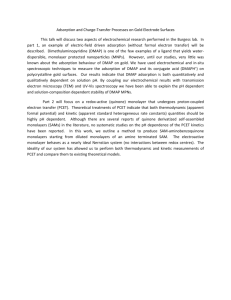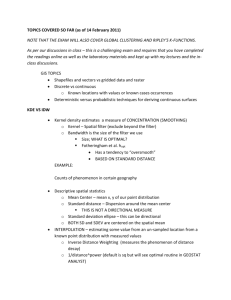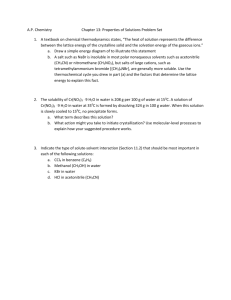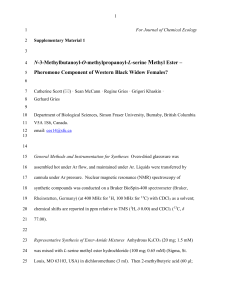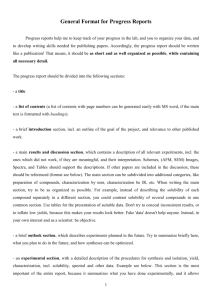POCl3/POBr3 Dismutation: Dioxophosphonium Cation Synthesis
advertisement
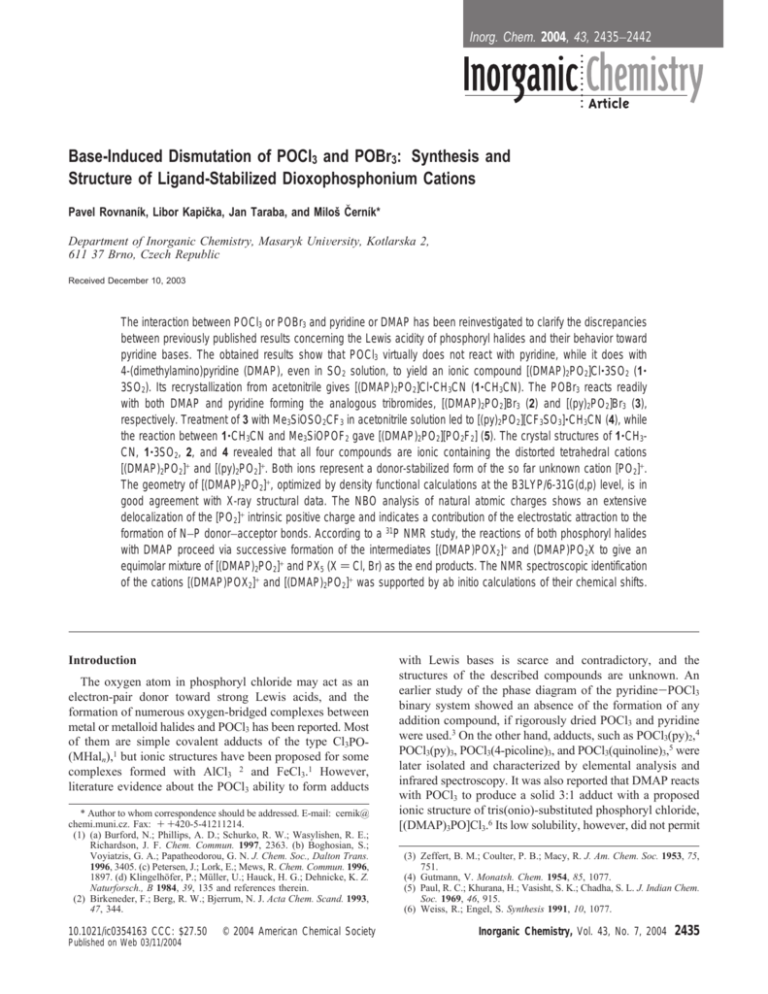
Inorg. Chem. 2004, 43, 2435−2442 Base-Induced Dismutation of POCl3 and POBr3: Synthesis and Structure of Ligand-Stabilized Dioxophosphonium Cations Pavel Rovnanı́k, Libor Kapička, Jan Taraba, and Miloš Černı́k* Department of Inorganic Chemistry, Masaryk UniVersity, Kotlarska 2, 611 37 Brno, Czech Republic Received December 10, 2003 The interaction between POCl3 or POBr3 and pyridine or DMAP has been reinvestigated to clarify the discrepancies between previously published results concerning the Lewis acidity of phosphoryl halides and their behavior toward pyridine bases. The obtained results show that POCl3 virtually does not react with pyridine, while it does with 4-(dimethylamino)pyridine (DMAP), even in SO2 solution, to yield an ionic compound [(DMAP)2PO2]Cl‚3SO2 (1‚ 3SO2). Its recrystallization from acetonitrile gives [(DMAP)2PO2]Cl‚CH3CN (1‚CH3CN). The POBr3 reacts readily with both DMAP and pyridine forming the analogous tribromides, [(DMAP)2PO2]Br3 (2) and [(py)2PO2]Br3 (3), respectively. Treatment of 3 with Me3SiOSO2CF3 in acetonitrile solution led to [(py)2PO2][CF3SO3]‚CH3CN (4), while the reaction between 1‚CH3CN and Me3SiOPOF2 gave [(DMAP)2PO2][PO2F2] (5). The crystal structures of 1‚CH3CN, 1‚3SO2, 2, and 4 revealed that all four compounds are ionic containing the distorted tetrahedral cations [(DMAP)2PO2]+ and [(py)2PO2]+. Both ions represent a donor-stabilized form of the so far unknown cation [PO2]+. The geometry of [(DMAP)2PO2]+, optimized by density functional calculations at the B3LYP/6-31G(d,p) level, is in good agreement with X-ray structural data. The NBO analysis of natural atomic charges shows an extensive delocalization of the [PO2]+ intrinsic positive charge and indicates a contribution of the electrostatic attraction to the formation of N−P donor−acceptor bonds. According to a 31P NMR study, the reactions of both phosphoryl halides with DMAP proceed via successive formation of the intermediates [(DMAP)POX2]+ and (DMAP)PO2X to give an equimolar mixture of [(DMAP)2PO2]+ and PX5 (X ) Cl, Br) as the end products. The NMR spectroscopic identification of the cations [(DMAP)POX2]+ and [(DMAP)2PO2]+ was supported by ab initio calculations of their chemical shifts. Introduction The oxygen atom in phosphoryl chloride may act as an electron-pair donor toward strong Lewis acids, and the formation of numerous oxygen-bridged complexes between metal or metalloid halides and POCl3 has been reported. Most of them are simple covalent adducts of the type Cl3PO(MHaln),1 but ionic structures have been proposed for some complexes formed with AlCl3 2 and FeCl3.1 However, literature evidence about the POCl3 ability to form adducts * Author to whom correspondence should be addressed. E-mail: cernik@ chemi.muni.cz. Fax: + +420-5-41211214. (1) (a) Burford, N.; Phillips, A. D.; Schurko, R. W.; Wasylishen, R. E.; Richardson, J. F. Chem. Commun. 1997, 2363. (b) Boghosian, S.; Voyiatzis, G. A.; Papatheodorou, G. N. J. Chem. Soc., Dalton Trans. 1996, 3405. (c) Petersen, J.; Lork, E.; Mews, R. Chem. Commun. 1996, 1897. (d) Klingelhöfer, P.; Müller, U.; Hauck, H. G.; Dehnicke, K. Z. Naturforsch., B 1984, 39, 135 and references therein. (2) Birkeneder, F.; Berg, R. W.; Bjerrum, N. J. Acta Chem. Scand. 1993, 47, 344. 10.1021/ic0354163 CCC: $27.50 Published on Web 03/11/2004 © 2004 American Chemical Society with Lewis bases is scarce and contradictory, and the structures of the described compounds are unknown. An earlier study of the phase diagram of the pyridine-POCl3 binary system showed an absence of the formation of any addition compound, if rigorously dried POCl3 and pyridine were used.3 On the other hand, adducts, such as POCl3(py)2,4 POCl3(py)3, POCl3(4-picoline)3, and POCl3(quinoline)3,5 were later isolated and characterized by elemental analysis and infrared spectroscopy. It was also reported that DMAP reacts with POCl3 to produce a solid 3:1 adduct with a proposed ionic structure of tris(onio)-substituted phosphoryl chloride, [(DMAP)3PO]Cl3.6 Its low solubility, however, did not permit (3) Zeffert, B. M.; Coulter, P. B.; Macy, R. J. Am. Chem. Soc. 1953, 75, 751. (4) Gutmann, V. Monatsh. Chem. 1954, 85, 1077. (5) Paul, R. C.; Khurana, H.; Vasisht, S. K.; Chadha, S. L. J. Indian Chem. Soc. 1969, 46, 915. (6) Weiss, R.; Engel, S. Synthesis 1991, 10, 1077. Inorganic Chemistry, Vol. 43, No. 7, 2004 2435 Rovnanı́k et al. 31P one to record the NMR spectrum or to grow single crystals for an X-ray structure determination, and thus, a reliable structural assignment of this compound is not yet available. Analogous complexes of POBr3 were even less frequently studied. Covalent 1:1, 1:2, or 1:3 molecular adducts of POBr3 with metal bromides or chlorides7 have been described, while 1:3 or 1:4 donor-acceptor complexes are allegedly formed with pyridine, 4-picoline, quinoline, and piperidine.5 In contrast to POCl3, the isovalent SiCl4 exhibits distinct properties of a Lewis acid and with suitable bases forms neutral adducts, e.g. SiCl4(py)2,8 as well as cationic complexes with a ligand-stabilized [SiCl2]2+ dication, e.g. [SiCl2(NMI)4]2+ (NMI ) N-methylimidazole).9 In both types of compounds the central silicon is six-coordinated with chlorine atoms and unidentate nitrogen bases, showing a slightly distorted octahedral geometry. To clarify the differences between chemical reactivities of POCl3 and SiCl4 toward Lewis bases and to elucidate the nature of the resulting complexes, reactions of POCl3 with pyridine and DMAP have been reexamined and a parallel study with POBr3 has been performed to enable a comparison with POCl3. Experimental Section Materials and Apparatus. All reactions and manipulations of air-sensitive reagents were carried out under strictly anhydrous conditions using standard grease-free glass vacuum line and Schlenk techniques. Solvents and pyridine were dried over P4O10, distilled from CaH2, and stored over activated molecular sieves. DMAP was dried over 4 Å molecular sieve and sublimed in vacuo. Phosphorus oxide chloride (Riedel-de Haën) was crystallized twice at 0-0.5 °C, i.e., slightly under its freezing point, and distilled. Phosphorus oxide bromide was prepared by following the published procedure10 and sublimed under vacuum. Me3SiOSO2CF3 (Aldrich) was used without further purification. Me3SiOP(O)F2 was prepared by the reaction of hexamethyldisiloxane with POF3 at room temperature and fractionated under vacuum.11 Gravimetric chemical analysis was carried out for halogens and phosphorus. The fluoride was determined as PbBrF after steam distillation,12 chloride and bromide were determined as AgCl and AgBr, respectively, and phosphorus was determined as quinolinium phosphomolybdate.13 The pyridines were distilled off from concentrated alkaline solutions and determined acidimetrically. The 1H, 19F, and 31P NMR spectra were recorded on a Bruker Avance DPX 300 spectrometer using a 5 mm multinuclear QNP probe head and operating at 300.00, 282.40, and 121.49 MHz, respectively. Chemical shifts, in ppm, are referenced relative to external standards Me4Si (1H), CFCl3 (19F), and 85% H3PO4 (31P) with negative shifts being upfield from the reference signal. D2O was used as an external 2H lock. (7) (a) Wartenberg, E. W.; Goubeau, J. Z. Anorg. Allg. Chem. 1964, 329, 269. (b) van der Veer, W.; Jellinek, F. Recl. TraV. Chim. 1970, 89, 833. (c) Okuda, T.; Ishihara, H.; Yamada, K.; Negita, H. Bull. Chem. Soc. Jpn. 1978, 51, 1273 and references therein. (8) Bechstein, O.; Ziemer, B.; Hass, D.; Trojanov, S. I.; Rybakov, V. B.; Maso, G. N. Z. Anorg. Allg. Chem. 1990, 582, 211. (9) Hensen, K.; Mayr-Stein, R.; Stumpf, T.; Pickel, P.; Bolte, M.; Fleischer, H. J. Chem. Soc., Dalton Trans. 2000, 473. (10) Gerrard, W.; Nechvatal, A.; Wyvill, P. L. Chem. Ind. 1947, 437. (11) Cavell, R. G.; Leary, R. D.; Tomlinson, A. J. Inorg. Chem. 1972, 11, 2573. (12) Pietzka, G.; Ehrlich, P. Angew. Chem. 1953, 65, 131. (13) Dahlgren, S. E. Z. Anal. Chem. 1962, 189, 243. 2436 Inorganic Chemistry, Vol. 43, No. 7, 2004 Preparation of [(DMAP)2PO2]Cl‚3SO2 (1‚3SO2). In a typical procedure, DMAP (1.55 g, 12.7 mmol) was dissolved in liquid SO2 (6.55 g) in a two-bulbed reaction vessel with an integral sinteredglass filter and two Rotaflo valves. POCl3 (1.98 g, 12.9 mmol) was condensed onto the frozen solution at -196 °C. Upon warming of the sample to room temperature and mixing, the vessel was allowed to stand at 20 °C for 7 days. Thereafter, ca. 80% of the solvent (5.11 g) was distilled off at -30 °C and the vessel was left overnight at ambient temperature. The deposited colorless crystals of 1‚3SO2 were filtered off and dried shortly under vacuum. At reduced pressure, however, the crystals disintegrated readily evolving SO2 even at -10 °C, and chemical analysis revealed that their composition depended upon the length of pumping. The formula 1‚3SO2 is therefore derived from the results of X-ray structure analysis. Yield: 2.27 g (67%). 1H NMR (SO2): δ 4.35 (s, 12H), 7.94 (d, 4H), 9.34 (d, 4H). 31P NMR (SO2): δ -13.7 (s). Preparation of [(DMAP)2PO2]Cl‚CH3CN (1‚CH3CN). The recrystallization of 1‚3SO2 (1.92 g) from hot acetonitrile (70 °C) gave colorless crystals of 1‚CH3CN. Yield: 1.14 g (83%). 1H NMR (SO2): δ 4.35 (s, 12H), 7.94 (d, 4H), 9.34 (d, 4H). 31P NMR (SO2): δ -13.7 (s). Mp: 246 °C. Anal. Calcd for C16H23ClN5O2P: Cl, 9.24; N(pyridinic), 7.30; P, 8.07. Found: Cl, 9.39; N(pyridinic), 7.93; P, 8.15. Preparation of [(DMAP)2PO2][Br3] (2). The mixture of 3 (2.64 g, 5.6 mmol) and DMAP (1.54 g, 12.66 mmol) was dissolved in liquid SO2 (9.51 g) to give a brown solution, which was allowed to stand at room temperature for 1 h. The volatile materials were removed in vacuo to leave a brown solid. The crude product was recrystallized from hot CH3CN, filtered off, and vacuum-dried. Yield: 2.25 g (72%). 1H NMR (SO2): δ 4.23 (s, 12H), 7.90 (d, 4H), 9.21 (d, 4H). 31P NMR (SO2): δ -13.7 (s). Mp: 217-218 °C (dec). Anal. Calcd for C14H20Br3N4O2P: Br, 43.82; N(pyridinic), 5.12; P, 5.66. Found: Br, 44.03; N(pyridinic), 5.56; P, 5.49. Preparation of [(py)2PO2][Br3] (3). An excess of pyridine (1.5 mL, 22.9 mmol) was added dropwise to the stirred solution of POBr3 (4.50 g, 15.6 mmol) in CH3CN (14 mL) at 0 °C. The resulting yellow solution was allowed to warm to room temperature and stand for 2 days. The precipitated pale yellow, microcrystalline solid was separated by filtration, washed with CH2Cl2, and dried in vacuo. Attempts to obtain single crystals suitable for X-ray structure determination were not successful. Yield: 6.21 g (86%). 1H NMR (SO ): δ 9.36 (d, 4H), 9.86 (t, 2H), 10.43 (d, 4H). 31P 2 NMR (SO2): δ -14.2 (s). Mp: 163-164 °C (dec). Anal. Calcd for C10H10Br3N2O2P: Br, 52.01; N(pyridinic), 6.08; P, 6.72. Found: Br, 52.56; N(pyridinic), 5.84; P, 6.67. Preparation of [(py)2PO2][CF3SO3]‚CH3CN (4). Liquid Me3SiOSO2CF3 (0.196 g, 0.88 mmol) was added to a solution of 3 (0.204 g, 0.44 mmol) in CH3CN (3 mL) and stirred for 1 h at room temperature. The solution was evaporated to half of the original volume and slowly cooled to 0 °C to give colorless crystals of 4 suitable for X-ray diffraction study. Yield: 0.114 g (64%). 19F NMR (CH3CN): δ -78.9 (s). 31P NMR (CH3CN): δ -14.6 (s). Preparation of [(DMAP)2PO2][PO2F2] (5). 1‚CH3CN (0.32 g, 0.93 mmol) was added to a solution of Me3SiOP(O)F2 (0.19 g, 1.10 mmol) in CH3CN (17 mL). The mixture was heated to 80 °C for 2 h, until all the solid dissolved. A white solid that precipitated upon cooling to ambient temperature was filtered off and vacuumdried. Yield: 0.290 g (77%). 19F NMR (CH3CN): δ -82.1 (d, 1JPF ) 949 Hz). 31P NMR (CH3CN): δ -12.6 (t, 1JPF ) 949 Hz), -13.7 (s). Anal. Calcd for C14H20F2N4O4P2: F, 9.31; N(pyridinic), 6.86; P, 15.17. Found: F, 8.93; N(pyridinic), 7.15; P, 15.08. X-ray Structure Determinations for 1‚3SO2, 1‚CH3CN, 2, and 4. The intensity data of 1‚3SO2, 1‚CH3CN, 2, and 4 were collected Base-Induced Dismutation of POCl3 and POBr3 on a KUMA KM-4 CCD κ-axis diffractometer equipped with an Oxford Cryosystem LT-device using graphite monochromatized Mo KR radiation (λ ) 0.71069 Å). The data sets were collected at -153 °C and corrected for absorption effects using ψ-scans. The structures were solved by direct methods. Non-hydrogen atoms were refined to F2 anisotropically while hydrogen atoms were placed in calculated positions and isotropically refined assuming a “ride-on” model. The SHELX-9714 program package was used for the structure determination, structure refinement, and tables. The drawings were made using the XP program of Bruker SHELXTL V5.1 program package.15 Final unit cell parameters were obtained from a least-squares fit to the angular coordinates of all reflections. Crystal structure data have been deposited at the Cambridge Crystallographic Data Centre as supplementary publication Nos. CCDC 193256 (1‚CH3CN), CCDC 219201 (2), and CCDC 219200 (4). Enquires for data can be directed to CCDC, 12 Union Rd., Cambridge CB2 1EZ, U.K., or (E-mail) deposit@ccdc.cam.ac.uk. Computational Methods The quantum chemical calculations were performed using Gaussian 98 program package.16 The geometries of the isolated cations [(DMAP)2PO2]+ (C2V symmetry) and [(DMAP)POCl2]+ (Cs) and the neutral molecule (DMAP)PO2Cl (Cs) were calculated by density functional theory (DFT) and optimized at the B3LYP level17 using polarized 6-31G(d,p) basis set.18 The natural atomic charges19 were calculated at the B3LYP/6-31G(d,p) level using the NBO analysis. The 31P nuclear shieldings were calculated by SOS-DFPT method at the PW91/IGLO-III level using deMon-KS program.20 Theoretical 31P nuclear shieldings were converted to chemical shifts by the δ ) 328.35 - σtheor relation, where the reference is the absolute shielding scale for 31P.21 Results and Discussion Reactions of POCl3 with Pyridine and DMAP. This study has confirmed the previously reported3 inertness of dry pyridine toward POCl3, if the latter was thoroughly purified from its hydrolysis products, HCl and HPO2Cl2. On the other hand, DMAP, as a stronger Lewis base,22 reacts readily with POCl3 in acetonitrile solution and a white solid precipitates immediately. The isolated product is only (14) Sheldrick, G. M. SHELX-97. Program for Crystal Structure Determination; University of Göttingen: Göttingen, Germany, 1997. (15) Sheldrick, G. M. SHELXTL V 5.1; Bruker AXS Inc.: Madison, WI, 1998. (16) Frisch, M. J.; Trucks, G. W.; Schlegel, H. B.; Scuseria, G. E.; Robb, M. A.; Cheeseman, J. R.; Zakrzewski, V. G.; Montgomery, J. A., Jr.; Stratmann, R. E.; Burant, J. C.; Dapprich, S.; Millam, J. M.; Daniels, A. D.; Kudin, K. N.; Strain, M. C.; Farkas, O.; Tomasi, J.; Barone, V.; Cossi, M.; Cammi, R.; Mennucci, B.; Pomelli, C.; Adamo, C.; Clifford, S.; Ochterski, J.; Petersson, G. A.; Ayala, P. Y.; Cui, Q.; Morokuma, K.; Malick, D. K.; Rabuck, A. D.; Raghavachari, K.; Foresman, J. B.; Cioslowski, J.; Ortiz, J. V.; Baboul, A. G.; Stefanov, B. B.; Liu, G.; Liashenko, A.; Piskorz, P.; Komaromi, I.; Gomperts, R.; Martin, R. L.; Fox, D. J.; Keith, T.; Al-Laham, M. A.; Peng, C. Y.; Nanayakkara, A.; Gonzalez, C.; Challacombe, M.; Gill, P. M. W.; Johnson, B. G.; Chen, W.; Wong, M. W.; Andres, J. L.; Head-Gordon, M.; Replogle, E. S.; Pople, J. A. Gaussian 98, revision A.7; Gaussian, Inc.: Pittsburgh, PA, 1998. (17) Lee, C.; Yang, W.; Parr, R. G. Phys. ReV. 1988, B37, 785. (18) Hehre, W. J.; Radom, L.; Schleyer, P. v. R.; Pople, J. A. Ab Initio Molecular Theory; Wiley: New York, 1986. (19) Reed, A. E.; Curtiss, L. A.; Weinhold, F. Chem. ReV. 1988, 88, 899. (20) Malkin, V. G.; Malkina, O. L.; Casida, M. E.; Salahub, D. R. J. Am. Chem. Soc. 1994, 116, 5898. (21) Jameson, C. J.; de Dios, A. C.; Jameson, A. K. Chem. Phys. Lett. 1990, 167, 575. (22) Maria, P.-C.; Gal, J.-F. J. Phys. Chem. 1985, 89, 1296. Figure 1. Time-dependent 31P NMR spectra of a reaction mixture with the molar ratio DMAP:POCl3 ) 1:1.4 in SO2 solution: (a) 5 min; (b) 2 h; (c) 2 days; (d) 8 days. sparingly soluble in acetonitrile but well soluble in the liquid sulfur dioxide. Its 31P NMR spectrum in SO2 solution consists of four singlets between 13.0 and -13.7 ppm, suggesting the presence of a mixture of compounds. When POCl3 was treated with DMAP directly in liquid SO2, the reaction proceeded at a much slower rate, and after several days colorless crystals grew from the solution. The 31 P NMR spectrum of their solution in SO2 showed a singlet at -13.6 ppm, thus indicating that only a single phosphorus compound was formed. Its X-ray single-crystal structure determination surprisingly revealed an ionic structure of the bis(4-(dimethylamino)pyridine)dioxophosphonium chloride, solvated by sulfur dioxide (1‚3SO2). Owing to a slight disorder in the SO2 molecules, however, only imperfect structural data (R1 ) 0.1082) could be obtained. Recrystallization of 1‚3SO2 from hot acetonitrile led to SO2 displacement, and an X-ray diffraction study of the obtained product revealed the structure of an acetonitrile solvate 1‚CH3CN with a fully acceptable value of R1 (0.0302). The course of the reaction between DMAP and POCl3 in a SO2 solution was followed by monitoring the time dependence of relative intensities of the 31P NMR signals (Figure 1). The signals at -13.7, -8.7, and 8.3 ppm can be assigned to 1, (DMAP)PO2Cl,23 and POCl3, respectively. The gradually disappearing peak at 13.0 ppm was assigned to the [(DMAP)POCl2]+ ion, which has been presumed earlier to exist in the binary POCl3-pyridine system on the basis of conductivity measurements.4 This assignment was supported by the calculation of isotropic 31P chemical shifts for the [(DMAP)POCl2]+, [(DMAP)2PO2]+, and [(py)2PO2]+ ions and the previously reported adduct (DMAP)PO2Cl.23 The results are presented and compared with the observed values in Table 4. Shift differences found for the already reported compounds (DMAP)PO2Cl and [(DMAP)2PO2]Cl are lower than 6 ppm. Such a good agreement of calculated shifts with the experimental ones strongly supports our NMR identification of the [(DMAP)POCl2]+ cation. On the basis of this assignment and the gradual changes in signal intensities, we have proposed a likely reaction (23) Teichmann, H.; Schulz, J.; Costisella, B.; Habisch, D. Z. Anorg. Allg. Chem. 1991, 606, 233. Inorganic Chemistry, Vol. 43, No. 7, 2004 2437 Rovnanı́k et al. Scheme 1 Figure 2. ORTEP representation of [(DMAP)2PO2]+Br3- (2) with 50% probability ellipsoids. pathway involving all observed species (Scheme 1). In the initial step, a base-induced ionization of POCl3 proceeds under heterolytic cleavage of one P-Cl bond and the simultaneous formation of the ion [(DMAP)POCl2]+. Its successive reaction with POCl3 gives presumably an intermediate, oxygen- and chlorine-bridged binuclear cation 6. This cation then undergoes a nucleophillic attack by Cl- ion and decomposes into betaine (DMAP)PO2Cl and PCl5. Subsequent displacement of the Cl- ion from (DMAP)PO2Cl by the more basic DMAP yields 1 as the final product. No NMR signals of the formed phosphorus pentachloride, either in its molecular or ionically dissociated [PCl4]+ and [PCl6]- forms, were detected due to its subsequent reaction with SO2, which yielded equimolar amounts of POCl3 and SOCl2.24 The formation of the latter was proved by Raman spectroscopy: the frequencies observed at 1231 (ν(SO)), 487 (νs(SCl)), 444 (νas(SCl)), and 343 (δs(SCl2)) cm-1 agree well with literature values reported for the fundamental modes of thionyl chloride.25 Reactions of POBr3 with Pyridine and DMAP. In contrast to POCl3, phosphorus oxide bromide reacts smoothly with both DMAP and pyridine to give crystalline products 2 and 3, respectively. Because 2 obtained in this way is often contaminated by intermediates sparingly soluble in acetonitrile, its preparation by the transamination of 3 with DMAP appears to be more reliable route. The molecular structure of 2 (Figure 2) was determined by X-ray crystal analysis. However, any attempts to grow suitable crystals of 3 have failed. For this reason, the tribromide 3 has been converted into a triflate 4, whose well-formed crystals allowed its crystal structure determination (Figure 3) without difficulties. In both cases, the reaction course is similar to that of the base-induced dismutation of POCl3. The apparent difference is that PBr5, formed in the reaction, decomposes to elemental bromine and PBr3, whose formation was confirmed by 31P NMR spectroscopy (s, 230.6 ppm). The liberated Br2 molecule adds readily on the bromide anion to give Br3-. In acetonitrile the resulting tribromides 2 and 3 are less soluble and crystallize from the reaction solution. The other signals observed at -33.5 and -24.7 ppm can be assigned to the donor-stabilized cations [(DMAP)POBr2]+ and [(py)POBr2]+, respectively. In contrast to the betaines (DMAP)PO2Cl and (py)PO2Cl, however, their bromine analogues are probably highly susceptible to a nucleophilic attack of another base molecule and convert easily into the corresponding donor-stabilized cations [(DMAP)2PO2]+ or Figure 3. Packing of [(DMAP)2PO2]+ and Br3- in the crystal structure of 2 viewed along the b-axis. Hydrogen atoms are omitted for clarity. 2438 Inorganic Chemistry, Vol. 43, No. 7, 2004 Base-Induced Dismutation of POCl3 and POBr3 Scheme 2 Table 1. Crystal and Structure Refinement Data for 1‚CH3CN, 2, and 4 chem formula fw temp (K) space group a (Å) b (Å) c (Å) R (deg) β (deg) γ (deg) V (Å) Z µ (mm-1) D (Mg/m3) R-indices [I > 2σ(I)] R-indices (all data) a 1‚CH3CN 2 4 C16H23ClN5O2P 383.81 120 P1h 8.910(2) 10.128(2) 10.282(2) 89.47(3) 82.93(3) 89.03(3) 920.6(3) 2 0.315 1.385 R1a ) 0.0302 R1 ) 0.0374 C14H20Br3N4O2P 547.04 120 P21/c 13.406(3) 12.932(3) 11.024(2) 90 93.77(3) 90 1907.1(7) 4 6.445 1.905 R1a ) 0.0525 R1 ) 0.0830 C13H13F3N3O5PS 411.29 120 P21/n 12.550(3) 8.810(2) 15.357(3) 90 93.95(3) 90 1693.9(6) 4 0.348 1.613 R1a ) 0.0395 R1 ) 0.0630 R1 ) ∑||Fo| - |Fc||/∑|Fo|. Table 2. Selected Bond Lengths (Å) and Angles (deg) for 1‚CH3CN and 2 and Calculated Parameters of [(DMAP)2PO2]+ calcd (B3LYP/6-31G(d,p)) 1‚CH3CN 2 P-O(1) P-O(2) P-N(1) P-N(2) C(arom)-N(arom)a C(arom)-C(arom)a Br(1)-Br(2) Br(2)-Br(3) 1.4671(11) 1.4626(12) 1.7653(12) 1.7476(12) 1.3666(18) 1.3892(19) 1.460(4) 1.465(4) 1.748(4) 1.728(4) 1.367(6) 1.381(7) 2.4842(10) 2.6015(10) 1.48 1.48 1.83 1.83 1.36 1.40 O(1)-P-O(2) O(1)-P-N(1) O(1)-P-N(2) O(2)-P-N(1) O(2)-P-N(2) N(1)-P-N(2) Br(1)-Br(2)-Br(3) 127.11(7) 105.45(6) 107.07(6) 107.53(6) 106.3(7) 100.66(6) 126.8(2) 106.7(2) 107.6(2) 105.7(2) 107.4(2) 99.4(2) 177.77(3) 134.7 104.4 104.4 104.4 104.4 99.6 a Average bond lengths. [(py)2PO2]+. For this reason, the 31P NMR signals of anticipated betaines, (DMAP)PO2Br and (py)PO2Br, have not been observed. The likely pathway of these reactions is shown in Scheme 2. Crystal Structures of [(DMAP)2PO2]Cl‚CH3CN (1‚ CH3CN) and [(DMAP)2PO2][Br3] (2). Crystallographic data for 1‚CH3CN and 2 are summarized in Table 1. Selected bond lengths and angles for 1‚CH3CN and 2, together with the calculated bond parameters of the [(DMAP)2PO2]+ cation, are listed in Table 2. The phosphorus atom in the [(DMAP)2PO2]+ ion exhibits in 1‚CH3CN and 2 (Figure 2) a strongly distorted tetrahedral coordination with bond angles ranging from 99.4 to 127.1°. The reported quantum-chemical calculations showed an increasing value of the O-P-O bond angle in the series [PO2]- anion (119.5°),26 [PO2]• radical (136.8°),27 and the linear [PO2]+ cation. The approximately 127° O-P-O angle in 1‚CH3CN and 2 thus illustrates a change in the [PO2]+ geometry caused by coordination of two DMAP molecules. However, the average P-O bond distance of 1.464 Å in 1‚CH3CN and 2 is only slightly longer than the value of 1.450 Å calculated for the hypothetical [PO2]+ ion at the B3LYP/6-31G(d,p) level and indicates a considerable multiple P-O bond order sustaining in [(DMAP)2PO2]+. Nearly equal P-O bond length of 1.457 Å in [PO2F2]- 28 suggests a comparable π-character of the P-O bonds in both ions. The high electronegativity of F-ligands apparently fully compensates the negative charge of the [PO2F2]- ion. The average P-N bond lengths of 1.756 Å (1‚CH3CN) and 1.738 Å (2) are somewhat longer then the single P-N bond in [PO2(NH2)2]- (1.678 Å)29 but significantly shorter than a typical P-N dative bond in the betaine (py)PS2Cl (1.849 Å).30 This shortening can be attributed to a greater Lewis acidity of [PO2]+ with respect to the PS2Cl molecule and in part to the overall positive charge of [(DMAP)2PO2]+. Pyridine rings in the [(DMAP)2PO2]+ ion are virtually planar and with torsion angles 91.3 and 83.3° roughly orthogonal to the N(1)-P(1)-N(2) plane in 2, while in 1‚ CH3CN two unequal torsion angles 52.7 and 80.1° have been observed. The geometry of the amine nitrogen is essentially also planar, indicating a considerable conjugation between the lone pair of the amine nitrogen and the π-system of the pyridine ring. Such a conjugation leads to a partly quinoidal character31 of the pyridinium system and, consequently, to a shortening of the ring bond distances C(1)-C(2) and C(4)C(5) and in exocyclic N(3)-C(3) and N(4)-C(10) bonds. With respect to the neat crystalline DMAP,32 the two former bonds in 2 are shorter by 0.03 Å, while the latter two are shortened by 0.05 Å. Similarly, as in crystalline DMAP, the dimethylamino group in 1‚CH3CN and 2 is slightly twisted from the pyridine ring plane and the corresponding torsion angle varies between 4.7 and 5.3° in both structures. Each [(DMAP)2PO2]+ ion in 2 exhibits two C-H‚‚‚O contacts which occur between its oxygen atoms and the hydrogen atoms of the nearest pyridine ring in a neighboring cation. The observed H‚‚‚O distances of 2.31 and 2.46 Å in C(2)-H(2)‚‚‚O(2)i and C(1)-H(1)‚‚‚O(1)i hydrogen bridges (symmetry codes (i): +x, 1/2 + y, 1/2 + z) are only moderately shorter than the sum of the van der Waals radii (2.74 Å). However, these weak C-H‚‚‚O interactions result in the formation of infinite cation chains with a half of their (24) (25) (26) (27) (28) (29) (30) (31) (32) Becke-Goehring, M.; Lehr, W. Chem. Ber. 1961, 94, 1591. Gillespie, R. J.; Robinson E. A. Can. J. Chem. 1961, 39, 2171. Xu, C.; de Beer, E.; Neumark, D. M. J. Chem. Phys. 1996, 104, 2749. Cai, Z. L.; Hirsch, G.; Beunker, R. J. Chem. Phys. Lett. 1996, 255, 350. Harrison, R. W.; Thompson, R. C.; Trotter, J. J. Chem. Soc. A 1966, 1775. Jacobs, H.; Nymwegen, R. Z. Anorg. Allg. Chem. 1997, 623, 849. Averbuch-Pouchot, M. T.; Meisel, M. Acta Crystallogr. 1989, C45, 1937. Kolomeitsev, A.; Schoth, R.-M.; Röschenthaler, G.-V. Chem. Commun. 1996, 335. Ohms, U.; Guth, H. Z. Krystallogr. 1984, 166, 213. Inorganic Chemistry, Vol. 43, No. 7, 2004 2439 Rovnanı́k et al. Table 3. Selected Bond Lengths (Å) and Angles (deg) for 4 P-O(1) P-O(2) P-N(1) P-N(2) C(arom)-N(arom)a C(arom)-C(arom)a a 1.4576(15) 1.4585(14) 1.7825(17) 1.797(17) 1.354(2) 1.376(7) O(1)-P-O(2) O(1)-P-N(1) O(1)-P-N(2) O(2)-P-N(1) O(2)-P-N(2) N(1)-P-N(2) 129.50(8) 106.30(8) 106.59(8) 107.28(8) 105.44(8) 97.10(8) Average bond lengths. DMAP rings stacked approximately in the ab plane. The other half of the rings, lying parallel to the bc plane, occupies intermittently lateral positions along both sides of the ac plane. These chains form channels, each of which is occupied by two parallel rows of approximately collinear Br3- anions (Figure 3). Anions in adjacent rows exhibit a reverse orientation. The Br3- in 2 is a discrete anion, and the shortest distance between the positively charged phosphorus in the [(DMAP)2PO2]+ cation and the surrounding bromines is 7.304 Å, which confirms a predominant ionic character of the compound. With its moderately disparate bond lengths (2.484 and 2.601 Å) and a slight deviation from linearity (177.8°), the geometry of Br3- is very close to that previously reported for [P(CH3)4][Br3].33 Two bromine atoms in each Br3- ion have always one long anion-cation C-H‚‚‚Br contact to the nearest pyridine molecule in the adjacent cation. Although the corresponding H‚‚‚Br distances, 2.93 and 3.05 Å, are only slightly shorter than the sum of the van der Waals radii (3.07 Å), the formation of weak C-H‚‚‚Br hydrogen bridges can be assumed. Their stability may be caused by an enhanced positive charge on the H atoms of the DMAP rings resulting from the formation of the dative N-P bond (Figure 5). The occurrence of similar C-H‚‚‚Cl bridges was encountered in an ionic complex [SiH2(py)4]Cl2‚4CHCl3.34 The separation between the adjacent DMAP ring layers lying in the bc plane is 5.27 Å, while in the b direction the inter-ring distances are even longer (6.01 Å). Both distances are too large, however, to enable a π-π stacking interactions of aromatic rings. Despite the very similar structural parameters of [(DMAP)2PO2]+ in 1‚CH3CN and 2, the cations exhibit different intermolecular interactions in particular crystal structures. In contrast to 2, neither the C-H‚‚‚O nor the C-H‚‚‚Cl intermolecular contacts involving the aromatic ring hydrogens have been observed in the crystal structure of 1‚CH3CN. Instead, only H‚‚‚O interactions (2.538 Å) with hydrogens of the dimethylamino group and certain very long H‚‚‚Cl contacts (2.978 Å) to the solvating acetonitrile have been found. Crystal Structure of [py2PO2][CF3SO3]‚CH3CN (4). The crystal data for 4 are given in Table 1, and important bond lengths and angles for the [(py)2PO2]+ cation are listed in Table 3. The crystal structure of 4 revealed that the coordination of [PO2]+ by different N-donor molecules (33) Robertson, K. N.; Bakshi, P. K.; Cameron, T. S.; Knop, O. Z. Anorg. Allg. Chem. 1997, 623, 104. (34) Hensen, K.; Stumpf, T.; Bolte, M.; Näther, C.; Fleischer, H. J. Am. Chem. Soc. 1998, 120, 10402. 2440 Inorganic Chemistry, Vol. 43, No. 7, 2004 Table 4. Calculated and Experimental Values of Chemical Shifts (ppm) for N-Donor Coordinated Molecules and Ions Observed in 31P NMR Spectra compd [(DMAP)POCl2]+ (I) [(DMAP)POCl2]+ (II) (DMAP)PO2Cl δcalcd δexpt 24.3 17.1 -3.1 13.0b [(DMAP)2PO2]+ -15.4 [(py)2PO2]+ -13.3 a [SbCl6 ]- 13.0b -8.620 -8.7b -13.618,a -13.7b -14.6b solvent SO2 CH3NO2 SO2 unknown SO2 SO2 b salt. This work. Figure 4. ORTEP representation of [(py)2PO2]+[CF3SO3]-‚CH3CN (4) with 50% probability ellipsoids. apparently does not affect substantially the geometry of the resulting complex and that the cation [(py)2PO2]+ (Figure 4) differs from [(DMAP)2PO2]+ mainly in the P-N bond lengths. Their lengthening by 0.03 and 0.05 Å with respect to the [(DMAP)2PO2]+ ion in 1‚CH3CN and 2, respectively, is consistent with the decreased Lewis basicity of pyridine relative to DMAP.22 A slight reduction of the N-P bond order is reflected also in the corresponding changes of bond angles. Consequently, the N-P-N angle in 4 is decreased by 2.3 or 3.6° with respect to the [(DMAP)2PO2]+ in 2 or 1‚CH3CN, while a simultaneous widening of the O-P-O angle by 2.7 or 3.6° occurs. We have found nothing unusual in the crystal packing of 4, and the [(py)2PO2]+ cations are without any contact below the sum of the van der Waals radii. The only observed intermolecular C-H‚‚‚O contacts (2.485 Å) occur between acetonitrile and an oxygen atom of the triflate anion. Comparison with Previous Reports on [(DMAP)2PO2]+ and Related Cations. The crystal structure analysis and 31P NMR spectroscopy revealed that compounds 1‚3SO2, 1‚CH3CN, and 2-5 can all be considered as salts of the donorstabilized [PO2]+ ion, an unknown analogue of the nitronium ion, [NO2]+. Recently reported attempts to produce the [PO2]+ ion by treatment of KPO2F2 with excess SbF5 failed to provide [PO2]+[SbF6]-, and an eight-membered oxygenbridged heterocycle, (SbF4O2PF2)2, was obtained instead.35 The ligand-stabilized cation, [(DMAP)2PO2]+, was previously prepared as triflate by a rather complex reaction between (35) Schneider, S.; Vij, A.; Sheehy, J. A.; Tham, F. S.; Schroer, T.; Christe, K. O. Z. Anorg. Allg. Chem. 2001, 627, 631. Base-Induced Dismutation of POCl3 and POBr3 CH3OP(O)Cl2, DMAP, and trimethylsilyl triflate.36 The isolated precipitate was briefly characterized by IR, 1H, and 31 P NMR spectra. However, the reported chemical shift at -19.08 ppm in CD3NO2 appears about 5 ppm upfield from the values obtained in the present work, although our results suggest that the 31P chemical shift of [(DMAP)2PO2]+ is neither solvent-dependent nor affected by its counterion. Later, the formation of [(DMAP)2PO2]+ and [(DMAP)2POS]+ obtained upon treatment of the betaines (DMAP)PO2Cl and (DMAP)POSCl, respectively, with excess DMAP was briefly mentioned.37 The crystalline salts were isolated as chlorides, tetraphenylborates, triflates, and hexachloroantimonates, but no experimental details were given, except for melting points and 31P chemical shifts. Although the used solvent was not specified, the reported chemical shifts between -13.6 and -14.2 ppm are in excellent agreement with our results. Similar donor-stabilized ions, [(py)2PS2]+ 38 and [(DMAP)2P(dNR)2]+,39 were described recently. Together with [(py)2PO2]+, [(DMAP)2PO2]+, and [(DMAP)2POS]+, they constitute an interesting series of bis(donor)-stabilized bis(chalcogeno/imino)phosphonium cations. Quantum Chemical Calculations. A comparison of experimental and ab initio optimized structural parameters of the PO2N2 moiety in [(DMAP)2PO2]+ ion (Table 2) shows a good agreement of almost all bond angles and P-O bond lengths, except for the calculated P-N bond length, which is longer by 0.074 or 0.092 Å than that found in crystalline 1‚CH3CN or 2. It should be taken into account, however, that the bond parameters were calculated for an isolated ion and need not be well comparable with the results of X-ray diffraction. Significant bond length differences between the gas phase and the solid state are indeed often encountered in complexes with dative bonds.40 The calculated bond lengths C(1)-C(2), C(4)-C(5), and C(3)-N(3) within the DMAP moiety in the [(DMAP)2PO2]+ ion are, relative to DMAP itself, shorter by 0.021, 0.021, and 0.032 Å, respectively. This slight shortening is in accordance with the predicted quinoidal character of the donor DMAP molecule and has been revealed by X-ray structure analysis. The distribution of natural atomic charges in the noncoordinated [PO2]+, DMAP, and the [(DMAP)2PO2]+ cation is shown in Figure 5. The total amount of charge transfer from both DMAP molecules to the [PO2]+ ion is 0.72 e and results in an extensive delocalization of its intrinsic positive charge. This calculated value is roughly comparable with the charge transfer of 0.54 and 0.58 electrons obtained experimentally for the gas-phase adducts (C5H5N)SO341 and (Me3N)SO3,42 respectively, where the SO3 is also a strong (36) Weiss, R.; Engel,S. Angew. Chem. 1992, 104, 239; Angew. Chem., Int. Ed. Engl. 1992, 31, 216. (37) Teichmann, H. Phosphorus, Sulfur, Silicon 1993, 76, 355/95. (38) Meisel, M.; Lönnecke, P.; Grimmer, A.-R.; Wulff-Molder, D. Angew. Chem. 1997, 109, 1940; Angew. Chem., Int. Ed. Engl. 1997, 36, 1869. (39) Blättner, M.; Nieger, M.; Ruban, A.; Schoeller, W. W.; Niecke, E. Angew. Chem. 2000, 112, 2876; Angew. Chem., Int. Ed. 2000, 39, 2768. (40) Leopold, K. R.; Canagaratna, M.; Phillips, J. A. Acc. Chem. Res. 1997, 30, 57 and references therein. (41) Hunt, S. W.; Leopold, K. R. J. Phys. Chem. 2001, 105A, 5498. Figure 5. Distribution of natural atomic charges in DMAP, [PO2]+, and [(DMAP)2PO2]+. Lewis acid. In comparison with the [PO2]+ ion and DMAP, the phosphorus and hydrogen atoms in [(DMAP)2PO2]+ become more positive, while the oxygen and donor nitrogen atoms more negative, indicating a contribution of electrostatic attraction to the formation of the N-P donor-acceptor bonds. In addition, an enhanced positive charge on the pyridine ring hydrogen atoms creates a precondition for the formation of intermolecular C-H‚‚‚O and C-H‚‚‚Br bridges, which have indeed been found in the crystal structure of 2. During the optimization of the [(DMAP)POCl2]+ ion geometry, two stationary points were obtained. The first one (I), with the DMAP ring lying in the O-P-N plane, has been characterized as being a true minimum on the potentional energy surface. The conformer II, in which the plane of DMAP ring is perpendicular to the O-P-N plane, has been characterized as first-order saddle point (one imaginary vibrational frequency revealed by the frequency analysis) and represents a transition state for the DMAP rotation around the N-P bond. The energy difference between I and II is 4.46 kcal mol-1. Reactions of 1‚CH3CN and 3 with Trimethylsilyl Phosphorodihalidates and Trifluoromethanesulfonate. The dihalogenophosphates [(DMAP)2PO2][PO2X2] (X ) F, Cl) can be considered ionic dimers of molecular betaines (DMAP)PO2X, and we have attempted their synthesis from 1‚CH3CN by appropriate anion exchange reactions. The readily accessible trimethylsilyl phosphorodifluoridate and phosphorodichloridate, which give with Cl- the volatile Me3SiCl as the leaving group, have been chosen as suitable sources of dihalogenophosphate groups. However, a different course of reactions between 1‚CH3CN and the two esters has been observed. Although the [(DMAP)2PO2]+ ion exhibits a considerable stability even in aqueous solution, an equilibrium between the cation, free DMAP, and the neutral betaine, (DMAP)PO2Cl, is established on heating in CH3CN solution. When the stoichiometric amount of Me3SiOP(O)Cl2 is then added, it is partly consumed in a side reaction with the released DMAP under formation of another betaine molecule.43 [(DMAP)2PO2]Cl h (DMAP)PO2Cl + DMAP (1) DMAP + Me3SiOP(O)Cl2 f (DMAP)PO2Cl + Me3SiCl (2) Thus, in addition to [(DMAP)2PO2][PO2Cl2], (DMAP)PO2Cl and other byproducts are formed as well. Inorganic Chemistry, Vol. 43, No. 7, 2004 2441 Rovnanı́k et al. On the other hand, if a solution of 1‚CH3CN is heated with Me3SiOP(O)F2, anion exchange occurs and, according to the 31P NMR spectroscopy, only pure 5 is formed. Instead of 1‚CH3CN, the tribromide 3 can also be used, and treatment of its acetonitrile solution with Me3SiOSO2CF3 yields the corresponding triflate 4. [(DMAP)2PO2]Cl + Me3SiOP(O)F2 f [(DMAP)2PO2][PO2F2] + Me3SiCl (3) [(py)2PO2]Br3 + Me3SiOSO2CF3 f [(py)2PO2][CF3SO3] + Me3SiBr + Br2 (4) Conclusions Previously only briefly described [(DMAP)2PO2]+ 36,37 and the new [(py)2PO2]+ cations have been synthesized as chlorides and tribromides by the treatment of phosphoryl chloride or bromide with pyridine bases. The formation of previously reported adducts4-6 in these reactions was not confirmed, and their existence seems to be doubtful. According to the results obtained, the POCl3 reacts only with DMAP, the strongest simple Lewis base,22 under heterolytic cleavage of one P-Cl bond in the first stage. In contrast to the neutral, mononuclear trans-SiCl4(py)2,8 no covalent POCl3 complex with hexacoordinated P-atom is formed, probably due to a steric hindrance against increasing of the coordination number exerted by the PdO double bond. With the exception of presumed intermediate 6, the tetracoordinated P-atom is maintained in all species involved in the (42) Fiacco, D. L.; Toro, A.; Leopold, K. R. Inorg. Chem. 2000, 39, 37. (43) Černı́k, M. To be published. 2442 Inorganic Chemistry, Vol. 43, No. 7, 2004 subsequent reaction steps. The formation of a cation [P(O)Cl(L)4]2+ (L ) Lewis base), analogous to the reported [SiCl2(NMI)4]2+,9 is thus hindered, and a base-catalyzed dismutation of POCl3 to PCl5 and ClPO2 occurs. The coordinatively unsaturated σ3-λ5-phosphorane ClPO244 is ligand-stabilized as the adduct (DMAP)PO2Cl, which is then transformed into the [(DMAP)2PO2]+ cation in its subsequent reaction with another DMAP molecule. The reactions of POBr3 with pyridines proceed analogously, but besides DMAP also the pyridine exhibits a sufficient Lewis basicity to initiate the dismutation process. From a mechanistic point of view, the observed base-induced dismutation of POCl3 and POBr3 closely resembles the pathway suggested recently for the F--catalyzed dismutation of POF3.45 The elucidation of these and other similar halogen/oxygen exchanges in halogenide oxides of pnicogens is, therefore, of particular interest and should attract further attention. Acknowledgment. This work was supported by the Ministry of Education of the Czech Republic (Grants MSM 143100011 and MSM 100000001). L.K. is grateful to the Brno Supercomputing Center for the computing time. Supporting Information Available: Crystallographic data in CIF format for complexes 1‚CH3CN, 2, and 4 and calculated Cartesian coordinates for [(DMAP)POCl2]+ and [(DMAP)2PO2]+ ions and betaine (DMAP)PO2Cl. This material is available free of charge via the Internet at http://pubs.acs.org. IC0354163 (44) Meisel, M.; Bock, H.; Solouki, B.; Kremer, M. Angew. Chem. 1989, 101, 1378; Angew. Chem., Int. Ed. Engl. 1989, 28, 1373. (45) Christe, K. O.; Dixon, D. A.; Schrobilgen, G. J.; Wilson, W. W. J. Am. Chem. Soc. 1997, 119, 3918.
